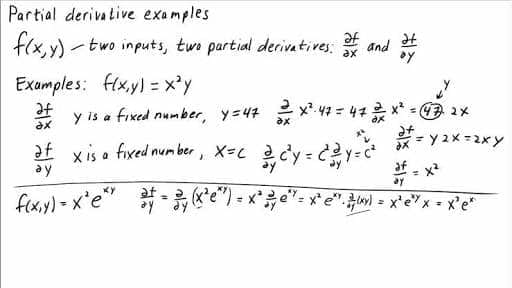Partial Derivative Calculator
Use the Partial Derivative Calculator below to solve your partial derivative related problems:
Instructions for Using the Partial Derivative Calculator
- Entering the Function:
- Locate the input field labeled “Function f(x, y):”.
- Enter your function in terms of variables
xandy. - You can use standard mathematical operations such as
+,-,*,/, and^for power. - Note that you must use * for multiplications, i.e.,
x*yinstead ofxy. - For trigonometric and other functions, use their usual notation, e.g.,
sin(x*y),cos(x),tan(y),log(x), etc.
- Selecting the Differentiation Variable:
- Next to the function input, you’ll find a dropdown menu labeled “Differentiate with respect to:”.
- Choose the variable with respect to which you want to compute the partial derivative. You can select either
xory.
- Computing the Derivative:
- Once you’ve entered your function and chosen the differentiation variable, click the “Compute” button.
- The calculator will process your input and display the result below the button.
- Reading the Result:
- The result will be displayed in the format:
∂/∂x (your function) = result - If there’s an error in your input or the function cannot be differentiated, an error message will be displayed. Ensure that your function is correctly formatted, and try again.
- The result will be displayed in the format:
- Tips:
- Ensure that you use proper mathematical notation for the best results.
- If the result seems too complex, try simplifying your input function or breaking it down into parts.
What is a partial derivative?
How do you compute it? For what purposes is it used for?
If you’re looking for answers to questions like these, then you’ve come to the right page. We will discuss the above questions as well as the various areas where partial derivates are used.
Table of Contents
What is a Partial Derivative?
The term contains two words: partial and derivative. The derivative of any algebraic expression is calculated with respect to a certain specified variable. This is done by differentiating the given function or expression with respect to the specified variable and it symbolizes the change in given function f(x) when the specified variable changes infinitesimally.
Also see our series on solving integral equations.
The derivative part is pretty clear when f(x) is composed of a single variable, but if it contains more than one variable then the inter-dependence of each variable also needs to be taken into account while calculating the derivative. And this is where the concept of “partial” derivative comes into play.
The partial derivative of a multi-variable expression with respect to a single variable is computed by differentiating the given function w.r.t. the desired variable whilst treating all other variables as constant, unlike the total differential where all variables can vary.
Partial derivatives symbolize instantaneous change in a given function relative to the infinitesimal change of variable under consideration. It is extensively used in differential geometry and vector calculus. Also, for optimization purposes, partial derivatives play a major role in every field and the total derivative can be computed step-by-step using partial derivatives.
Examples & Usage of Partial Derivatives

As stated above, partial derivative has its use in various sciences, a few of which are listed here:
Partial Derivatives in Optimization
Partial derivates are used for calculus-based optimization when there’s dependence on more than one variable.
Partial Derivatives in Geometry
To compute rate at which a certain geometric quantity, volume, surface area, etc., varies when a basic measurement (radius, height, length, etc) is varied.
Partial Derivatives in Mathematical Physics
Partial derivatives (rather partial differential equations) have extensive use in mathematical physics (and variational calculus, Fourier analysis, potential theory, vector analysis, etc).
Partial Derivatives in Thermodynamics
Partial derivatives in this case can be thermal variables or ratios of some variables like mole fractions in the Gibbs energy equation.
Partial Derivatives in Quantum Mechanics
Schrodinger wave equations and several other equations from quantum mechanics inherently use partial derivatives.
Partial Derivatives in Economics
Most functions explaining economic behavior statements like the behaviors depending on so and so variables in a particular manner, are obtained using the concept of partial derivates where independent variation in the behavior is observed by varying the fundamental variables one by one.
In addition to these partial derivatives are used in many other areas of education to calculate the differentiation of a function partially with respect to a variable.
Also see: Derivative of x squared is 2x, but can that be only x?
Notations used in Partial Derivative Calculator
Let f be a function in x,y and z.
First order partial derivatives are represented by
$ \dfrac{\partial f}{\partial x} = f_x$
Second order partial derivatives given by
$ \dfrac{\partial^2 f}{\partial x^2} = f_{xx}$
The mixed derivative is shown by
$ \dfrac{\partial^2 f}{\partial x^2} = f_{xx}$
Summarizing
As much use, partial derivatives have, they are equally difficult to compute at higher levels and hence online partial derivative calculators are designed to help the users simplify their computations. Above I have showcased a partial derivative calculator that solves partial derivative problems step by step, equipped with the functions of computing partial derivatives to cater to all your computational needs.
